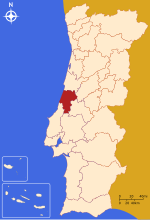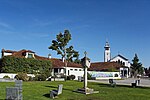Estádio Municipal da Marinha Grande
Buildings and structures in Leiria DistrictFootball venues in PortugalPortuguese sports venue stubsSport in LeiriaSports venues completed in 1992

Estádio Municipal da Marinha Grande is a football stadium in Marinha Grande, Portugal. It hosts football matches for Atlético Clube Marinhense and hosted the home matches of U.D. Leiria in 2002-03 when Estádio Dr. Magalhães Pessoa was being renovated. The stadium is able to hold 6,000 people and opened in 1992. In 2011–12, U.D. Leiria relocated again to Marinha Grande for 3 years, claiming excessive rent at Estádio Dr. Magalhães Pessoa, after it was relegated, the deal was abandoned and U.D. Leiria moved to Campo da Portela in Santa Catarina da Serra.
Excerpt from the Wikipedia article Estádio Municipal da Marinha Grande (License: CC BY-SA 3.0, Authors, Images).Estádio Municipal da Marinha Grande
Avenida da Liberdade, Marinha Grande
Geographical coordinates (GPS) Address Nearby Places Show on map
Geographical coordinates (GPS)
| Latitude | Longitude |
|---|---|
| N 39.736977 ° | E -8.931459 ° |
Address
Atlético Clube Marinhense
Avenida da Liberdade
2430-069 Marinha Grande
Portugal
Open on Google Maps









